Chicken feed – Chickens like people, really only need one thing to get by: a consistent source of nutrition they can depend on. Mealtimes are central to a healthy and fulfilling life. With that in mind, as a chicken owner, what your birds eat is the beginning and end of almost all of your problems.
A proper diet can prevent things like illnesses, obesity, agitation, and premature death. Moreover, it means your chicken will live a healthy life and will lay nutritious eggs. And, ultimately, isn’t that what really matters the most?
Join us today, as we discover some of the best nutrition plans for chickens available for feeding your precious chickens.
Feed Your Chickens The Right Way
Your chickens are an investment, whether emotional, financial, ethical, or a little bit of all three. It’s important you take care of them, and, next to housing them, the most important part of their healthcare is their diet.
Let’s take a closer look at some of the best ways for you to feed your flock. If you are going away for a few days, learn how long can chickens go without food and how a chicken feeder can help.
What Chicken Feed to Buy?
Pellets for Laying Hens
There’s no chicken who works harder than a laying hen. Laying hens have specially-designed commercial pellets and crumbles, designed to maintain their nutrients. While laying, hens should be fed these pellets on a daily basis, in order to stay in good health.
If hens have access to food all day long, they’re more likely to store excess pellets in their crop, just before bed.
This food, then, can be digested overnight, while they sleep. With these overnight nutrients coursing through their little bodies overnight, they’re more likely to produce eggs daily.
What to Feed Baby Chickens After Hatching: A Helpful Guide
Grits and Oyster Shells
Grits and oyster shells are considered a standard among chicken owners. Tiny rocks that chickens eat and swallow, these grits are essential in the digestion process for these birds. Without them, their absorption of nutrients can be slowed, leading to potential complications.
Variety is the spice of life, and chickens appreciate it as well.
In spite of the calcium in commercial chicken feed, it’s important for your birds to get it from a few different sources.
Start with a feeder full of coarse, broken up oyster shells. The calcium deposits in this will go a long way towards strengthening their bones and beaks. Both grits and oyster grindings should be offered to chickens as free range feed.
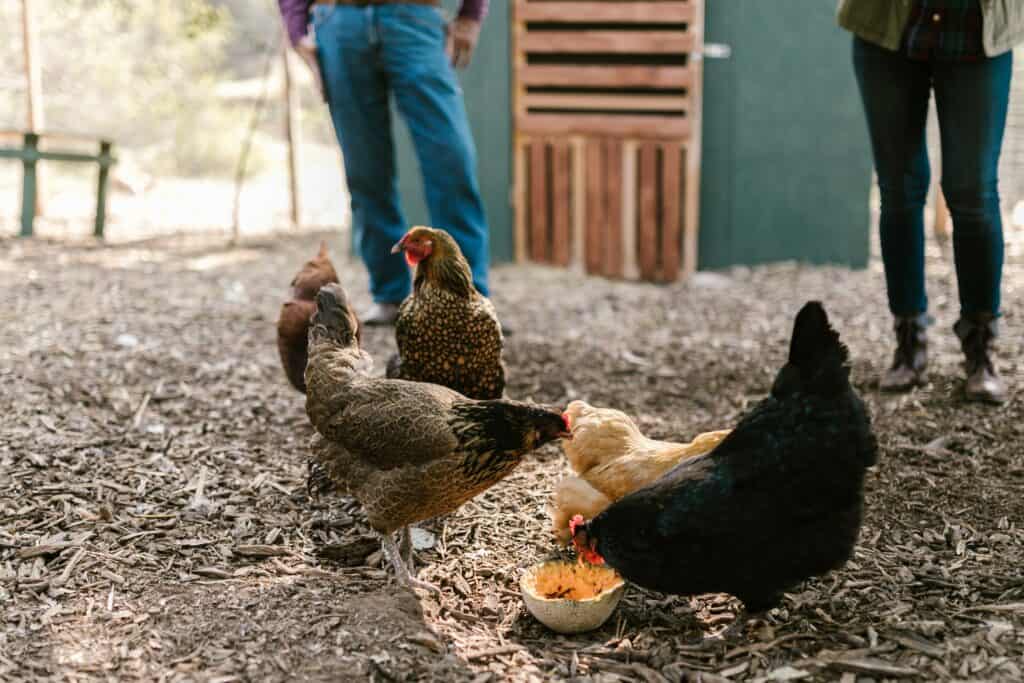
Vegetables and Table Scraps
You can call chickens a lot of things, but shy eaters isn’t one of them. The standard-sized hen has it in her to eat between a quarter and a third of a pound of pellets in any given day. But they shouldn’t only be eating pellets.
It’s crucial to make sure your chicken enjoys a varied and nutritious diet.
Cutoffs, leftovers, old vegetables and other table scraps are all foods that any chicken or hen would be happy to finish off on your behalf. It’s ideal to give chickens fruits that other birds or insects have gotten into such as tomatoes. Learn about how they should eat ripe instead of unripe tomatoes in can chickens eat tomatoes.
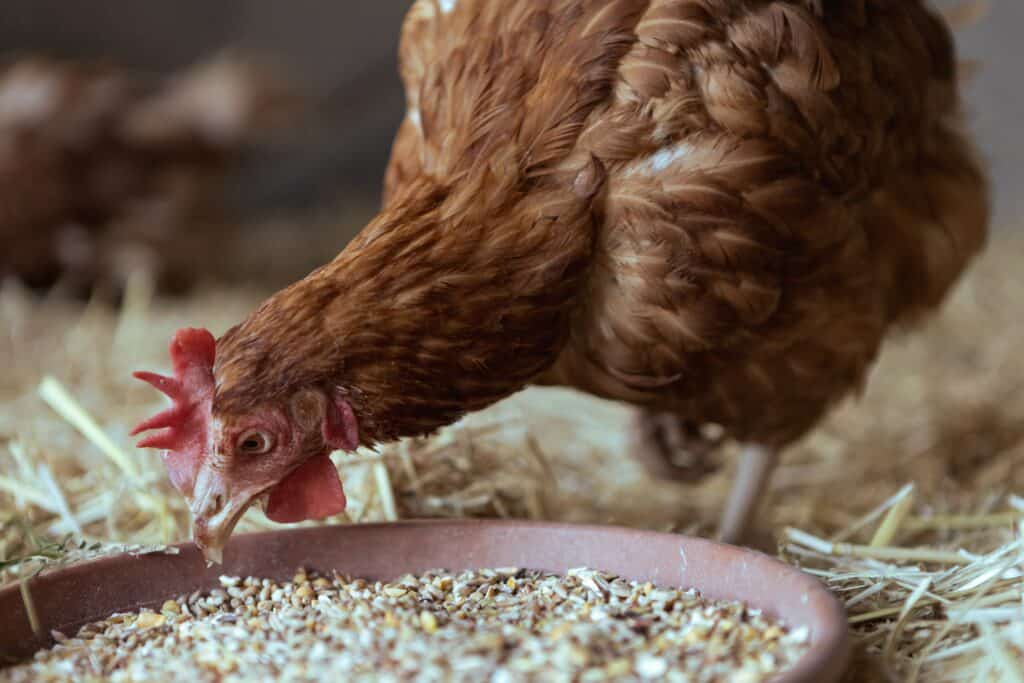
What to Feed Laying Hens
Coffee grounds might not seem worth the trouble to you, but can add nutrients and variety to their diet. Stalks, weeds and bruised or partially insect-eaten vegetables are all good candidates.
Free-Ranging
A good way to regulate your chicken’s diet and make sure they’re not being forced on any particular food is to come up with free-range options. Cut a large vegetable in half and hang it up in their cage.
Leave a bowl full of compost in the freezer overnight and have the chickens peck at the frozen mound to get the food they want.
Treats
Chickens are, by their nature, very animated animals, and there’s no time you’ll see them wilder than upon receiving a treat. You’ve got to be careful with what you feed them, and how much. Chickens can get fat, but, more than that, they can get sick.
Dole out cracked corn with caution. They love this treat, but it constitutes nothing but empty calories. Not only is this bad for them, but it can also lead to problems with their egg laying.
Similarly, sunflower seeds are a nice treat for birds, but should be given out in moderation, and never with the shell on.
Apples, pears and other fruits work quite well as well. Something to keep in mind, when it comes to the question of bird treats, is whether they encourage behavior among your chickens. Can Chickens Have Strawberries
Large bricks of bird treats sit in one place in a coop or cage, where chickens go over to peck at them. This means your birds are learning to sit tight and wait for food to come to them, without scratching, walking, or working in any way to get it.
Not only that, but they also tend to attract rodents. These are, by and large, best to be avoided. All in all, with birds as with people.
Everything is better in moderation.
Train your chickens to understand the sound of a shaking jar full of sunflower seeds to be something that happens from time to time.
A teaspoon of meal-worms is more than enough protein for any bird.
Keep your coop stocked with enough compost to foster the natural occurrence of grubs and bugs, for birds to peck at.
Fresh Water for Chickens
Often an afterthought, access to fresh water is actually the single most important part of your chicken’s diet. In order to keep dirt and grime out of the water, put it somewhere elevated off of the ground, and clean out the bowl weekly.
You’ll notice your chickens tend to prefer muddy water puddles, but, much like children, they need someone who knows better to take care of them.
Never underestimate how important water is. If your chickens don’t drink, for whatever reason, they can expire and die within 24 hours.
Note On Feeding Chicks
Young chicks are dependent on you to feed them, especially in the first few days of their life. Feed should be finely ground, containing no more than 18% protein.
This specialized chick feed should be administered for 14 to 18 weeks before they shift over to adult food. Finally, make sure not to feed them any additives or products that promise to promote or speed up their growth.
These are almost always used in growing meat birds, and the resultant spurt in their muscle growth is not healthy for them.
Change the Way You Use Your Chicken Feed
Taking care of your chickens is a 24-hour-a-day process. You need to make sure you’re feeding them properly, or their health can take a turn for the worse, quickly.
Whether you go for organic, high-fat, hand-made or store bought, a little nutrition goes a long way. Make sure you don’t over-stuff your birds on fatty foods, and always keep their well-being in mind during mealtimes.
Interested in learning more about bird rearing, rural living, and sustainable lifestyle tips? You can learn more about modern homesteading by paying us a small visit, today.
Best Chicken Feeder to Prevent Waste
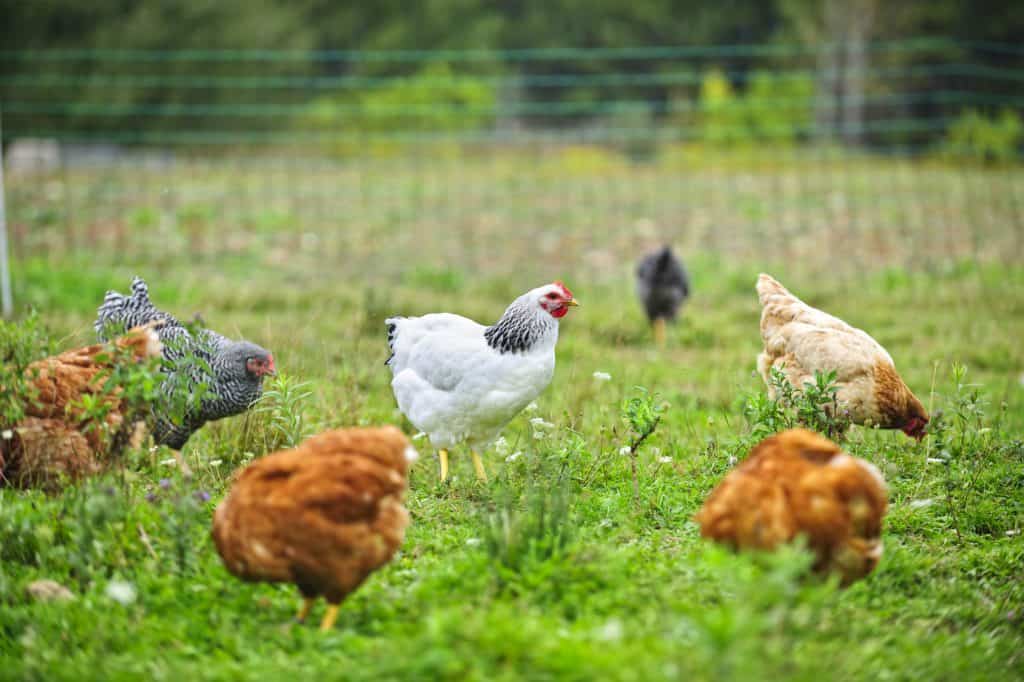
Feeding Chickens: What They Need at Different Stages
Did you know chickens today are almost five times bigger than their 1957 counterparts? A Canadian study shows this isn’t because they’ve been tanked up with hormones or other size-enhancing drugs.
The research concluded that it’s because we’ve bred chickens to be bigger over the years by giving preference to the larger ones.
So, it’s still a good idea to follow feeding guidelines for your chickens based on their age and stage in life.
Let’s take a look at how feeding chickens according to their stage can make all the difference.
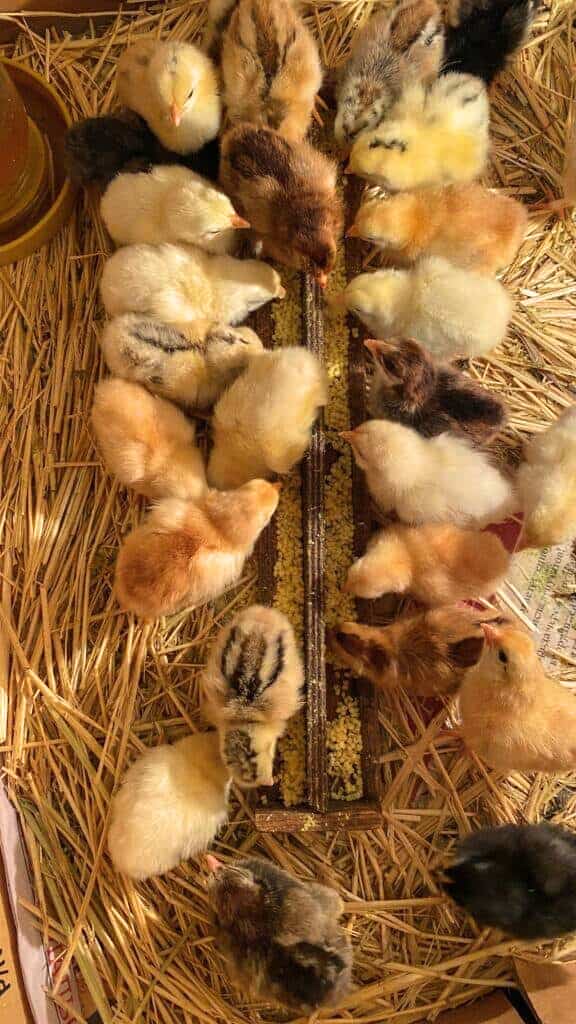
The Early Chick Stage
The early chick stage refers to the time between birth and about 8 weeks. Just as a growing infant needs certain nutrients to develop a healthy and strong body, so does a chick.
During this stage of life, chicks need what’s called a starter feed or starter crumble. This feed must contain at least 15% protein for the developing chicks.
If you are raising a small bantam chicken or a Serama chicken or other small chicken, the chicks will be smaller than from regular-sized hens. Be sure to feed bantam chicks crumbles or mash.
Medicated Diet
Medicated starter feed contains amproleum, which works to safeguards chicks from a fatal intestinal illness called coccidiosis. This illness is contracted through contact with feces.
This is why it’s important to keep your chicken coop from becoming too crowded and unclean. Warm, humid weather makes for a moist environment and is a breeding ground for coccidiosis. There is a coccidiosis vaccine. If your chicks have been vaccinated, it’s best not to choose the unmediated diet.
Unmedicated Diet
Unmedicated starter feed simply doesn’t have amproleum in it. This is best used if you’re at all unsure of whether your chicks have been vaccinated.
The Middle Chick Stage
The middle chick stage ranges from 8 to 18 weeks old. Think of this as your chicken’s teen years. This is when grower feed comes into play. The grower feed cuts the protein down from the starter feed during the early stage.
The protein content is about 15 – 17% and requires grit along with it. If you continue your chicks on a high protein diet, it can push them into laying eggs sooner than their bodies are ready for.
Laying Hens
When chicks reach 18 – 20 weeks, they may be prepared to start laying eggs. For your laying hens, you can choose the pellet, crumble or mash versions of layer feed.
Layer feed has vital calcium for eggshell production. The layer feed uses 15 – 17% protein with additional calcium for strong eggshells.
Even though there’s extra calcium, your laying hens will benefit from crumbled oyster shells presented in a separate bowl from the layer feed.
Laying hens will only ever eat as many oyster shells as they need. This helps ensure your hens don’t become depleted of calcium. Note that layer feed should never be given to chickens under 18 weeks of age. This is because the excess calcium can damage the kidneys, cause kidney stones to develop and can decrease the bird’s overall lifespan.
Chickens Laying Eggs With No Shell
Non-Laying Hens and Roosters
A maintenance diet is necessary for non-laying hens and roosters. This chicken feed still has the nutrients and vitamins that laying feed does, without the added calcium.
The maintenance diet can be accompanied by chicken scratch. Scratch is composed of various grains, one of which is typically cracked corn. And it’s very high in calories. Scratch should be used infrequently and in small amounts.
Feeding Chicken Snacks
The occasional treat for your chickens is fine. And they’ll love you for it. Just make sure not to allow them to indulge too often. Keep the snacks down to every couple days.
Chicken Treats
- Pumpkin rinds
- Mealworms
- Oatmeal balls
- Leftovers from dinner
Since chickens don’t have teeth, remember to provide grit to help them digest these snacks. Grit is made from sand or small pieces of stone.
Steer Clear of These Foods When Feeding Chickens
There are some foods that are toxic to your chickens and should be avoided at all costs.
- Avocado seeds and skin
- Dried beans
- Unripe tomatoes
- Green-tinted potatoes
- Chocolate
- Cocoa
- Any food with mold on it
Chickens Will Eat Anything
Remember, even though chickens can be cute and lovable, they’re not the brightest of the bunch. They’ll eat just about anything. So, be mindful of what’s in their exercise area. Especially watch for small plastic toys, nails, coins or bits of wire.
Joint Feeding Times
When you have a situation where you’ve many different age groups, don’t despair. These circumstances aren’t optimal, but they’re also quite common.
In this situation, it’s best to provide an un-medicated grower/starter diet, along with available calcium such as crushed oyster shells or eggshells.
Don’t forget to put the calcium supplement in a separate bowl to allow the hens to determine the amount they need.
This is the best solution because the extra protein won’t harm the older chickens. But the excessive calcium in layer feed can harm the developing kidneys of younger birds.
Open Versus Restricted Feeding
Chickens are generally grazers and only eat when they know they need to. For this reason, a free or open feeding schedule is best.
This gives your chickens the freedom to meet their own hunger needs and at their leisure.
Food Crisis
In the event of a food crisis on your farm or in your wallet, where you just don’t have access to the nutrient-rich diet mentioned above, do the best you can.
For instance, if you can’t afford or don’t have access to crushed oyster shells, feel free to use crushed eggshells. While it’s ideal to be able to afford feeder and supplements for your chickens, you can make do with alternatives.
And remember, the most crucial of all diets when feeding chickens is the laying hen’s diet. Her task is strenuous and exhausting. She needs all the calcium and protein she can get.
Feeding Chickens at Different Stages
When feeding chickens, you want to make sure you’re tailoring their diet to meet their specific needs. They’re omnivores and just like us, they need balanced nutrition to keep them strong.
For more tips and information on how to raise your animals to be their healthiest, check out our post on caring for livestock.Comparing the Best Chicken Swings
Water Your Backyard Chickens: Watering Systems and Ideas
Best Chicken Breeds
Keeping a Rooster Pros and Cons ~ Learn Which is Best for You
10 Tips for Raising Backyard Chickens for Beginners
Best Chicken Toys For Entertaining Your Backyard Chickens
Common Chicken Diseases and How to Treat Them
Best Chicken Coops

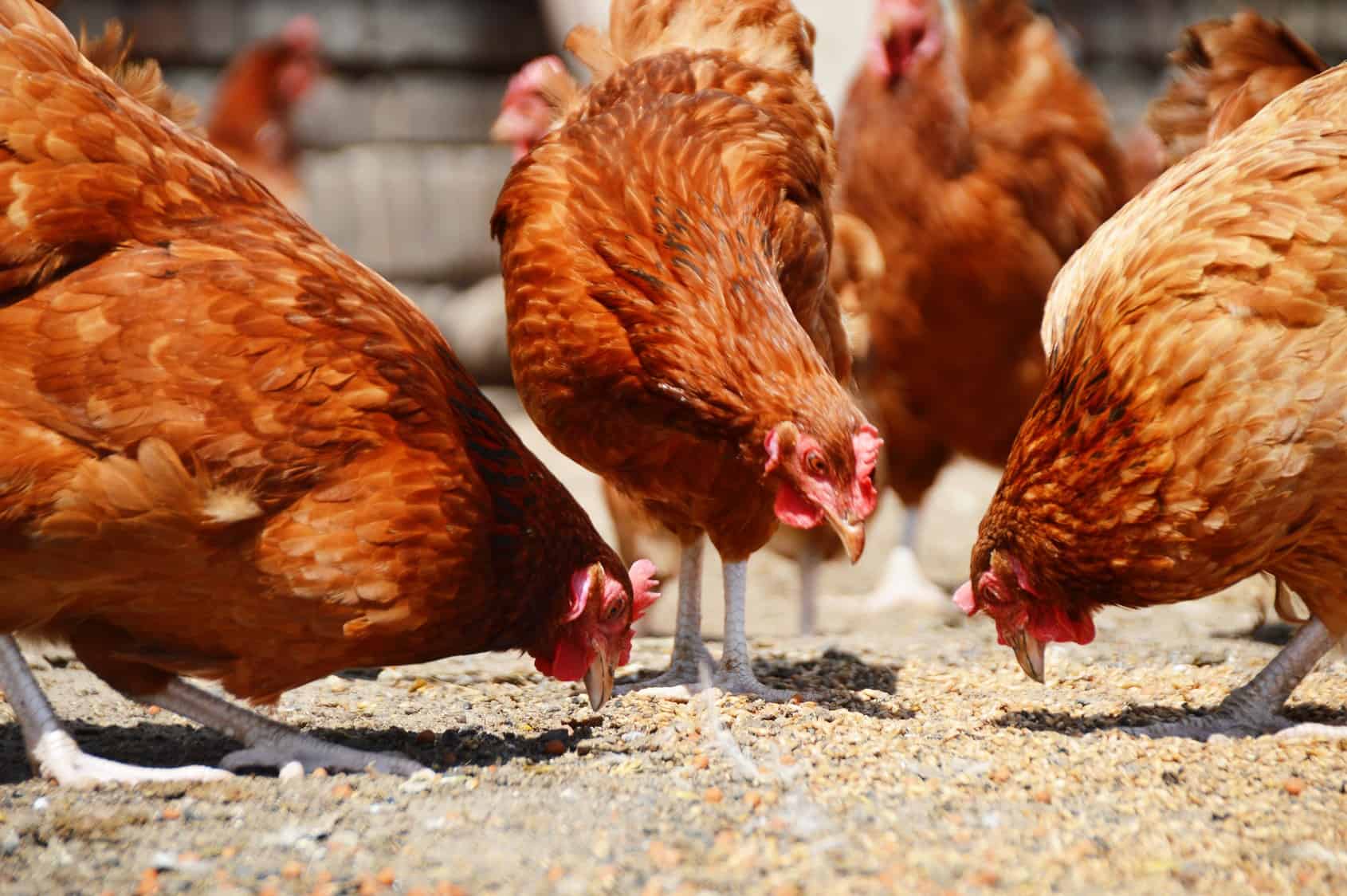
Hi. I enjoyed your article. Very informative. I have been researching what brands are the best for laying hens. Originally i was using dumor organic layer crumble but after my last 2 bags were basically powder and they had a weird smell i then changed to flock party layer crumbles. What are your thoughts on this brand? I could only find one review. Maybe it is new. Also since its winter and my girls aren’t laying should i still be giving them oyster shells? Thanks
Chickens need as much natural daylight (14-16 hours optimal) as they can get. In addition, their bodies also need rest to recover periodically so they really shouldn’t be laying as much during the winter. Hens dietary requirements and volume of food they eat will change as they prepare for dark and cold winter while their body recuperates for next spring.